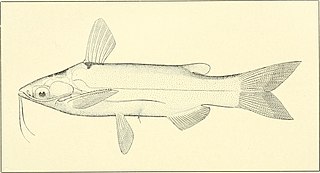The false discovery rate (FDR) is a method of conceptualizing the rate of type I errors in null hypothesis testing when conducting multiple comparisons. FDR-controlling procedures are designed to control the expected proportion of "discoveries" that are false. FDR-controlling procedures provide less stringent control of Type I errors compared to familywise error rate (FWER) controlling procedures, which control the probability of at least one Type I error. Thus, FDR-controlling procedures have greater power, at the cost of increased numbers of Type I errors.

The purple-bibbed whitetip is a species of hummingbird. It is native to Colombia, Ecuador, and Peru. Little is known about the species due to it rarely foraging in the open - in search for insects and small flowers. Nesting is made from foliage such as moss and ferns, usually along steep ravines.

The whitetips are a small group of hummingbirds in the genus Urosticte, which are restricted to humid forests growing on Andean slopes in north-western South America. Their common name, whitetips, refers to the conspicuous white tips on the central rectrices of the males. As the central rectrices are shorter than the outer, it appears as a large white spot on the central uppertail. Females, which have green-spotted white underparts, lack the white tips to the central rectrices, but instead have broad tips to the outer rectrices.

Entomocorus is a genus of catfishes of the family Auchenipteridae.

Entomocorus benjamini is a species of driftwood catfish found in the Madeira River system in Bolivia and Brazil. This species grows to a length of 7.0 cm and can be distinguished from it congeners in that the distal half of dorsal caudal fin lobe and the edge of the ventral lobe is pigmented. E. benjamini has been classified as an invertivore that feeds on aquatic and terrestrial invertebrates, zooplankton, and both aquatic and terrestrial vegetation. It has been noted that a single fish could ingest as many as 1700 planktonic crustaceans in a single night, when this species feeds near the water surface.

Catocala andromache, the andromache underwing, is a moth of the family Erebidae. It is found from southern California to Arizona.

Catocala benjamini, Benjamin's underwing, is a moth of the Erebidae family. It is found in Arizona, Nevada, southern California and southern Utah.

Lasionycta benjamini is a moth of the family Noctuidae. It is found in the Sierra Nevada of California and in the mountains of Nevada and Colorado.
Fusinus benjamini is a species of sea snail, a marine gastropod mollusk in the family Fasciolariidae, the spindle snails, the tulip snails and their allies.
Keyseria is an extinct genus of dicynodont therapsid. The type species K. benjamini was first named in 1948 as Dicynodon benjamini.

Yoav Benjamini is an Israeli statistician best known for development of the “false discovery rate” criterion.
Cyclophora benjamini is a moth in the family Geometridae. It is found in south-eastern North America, including Florida, Georgia and Mississippi.

Sybra is a genus of beetles in the family Cerambycidae, containing the following species:

Sybra ordinata is a species of beetle in the family Cerambycidae. It was described by Bates in 1873.
Itai Benjamini is an Israeli mathematician who holds the Renee and Jay Weiss Chair in the Department of Mathematics at the Weizmann Institute of Science.
Belisana benjamini, is a species of spider of the genus Belisana. It is endemic to Sri Lanka.
Tornos benjamini is a species of geometrid moth in the family Geometridae. It is found in Central America and North America.
Heliastus benjamini, the arroyo grasshopper, is a species of band-winged grasshopper in the family Acrididae. It is found in North America.
Sympistis benjamini is a species of owlet moth in the family Noctuidae. It is found in North America.









